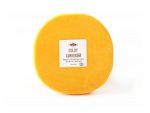Edam cheese (Dutch: Edammer kaas) originates from the town of Edam in the Netherlands and dates back to at least the 14th century. During the 16th and 17th centuries, Edam became one of the most exported cheeses in Europe due to its long shelf life and resistance to spoilage, making it ideal for sea voyages.
- In the Dutch Golden Age (17th century), Edam was one of the main trading goods of the Netherlands, widely consumed across Europe, the Americas, and Asia.
- Historically, it was made on farms and aged naturally, but modern production involves controlled aging in cheese factories.
- The distinctive red wax coating was introduced in the 19th century to protect the cheese during transport. Traditional Edam had no wax coating and aged naturally, forming a dry rind.
Today, Edam is produced not only in the Netherlands but also in other countries, including France, Spain, and Canada. However, “Noord-Hollandse Edammer” (North Holland Edam) is a Protected Designation of Origin (PDO) cheese, ensuring authenticity when produced in this Dutch region.
Manufacturing Process of Edam
1. Milk Selection and Processing
- Traditionally, cow’s milk is used, but goat’s milk Edam also exists.
- The milk is pasteurized, and starter cultures are added to begin acidification.
- Rennet is added to coagulate the milk, forming curds.
2. Curd Cutting and Draining
- The curds are cut into small pieces to release whey.
- The mixture is gently heated and stirred to expel more whey.
- The whey is drained, leaving firm curds.
3. Molding and Pressing
- The curds are placed into round molds and pressed to remove excess moisture.
- The cheese takes on its characteristic round shape, usually weighing between 1 to 2 kg.
4. Salting and Waxing
- The cheese is salted, either by soaking in brine or by dry salting.
- It is then coated in red or yellow wax to preserve moisture and aid aging.
5. Aging Process
- Young Edam (Jong Edammer) is aged for about 4 weeks, making it soft and mild.
- Aged Edam (Oud Edammer) can be aged for several months to over a year, becoming harder, more crumbly, and nutty in flavor.
- The longer it ages, the stronger and sharper its taste becomes.
Uses of Edam Cheese in Cooking
1. Slicing and Snacking
- Young Edam is mild, smooth, and creamy, making it ideal for sandwiches and cheese boards.
- Often paired with fruits like apples, pears, and grapes.
- Served with crackers, nuts, and cured meats.
2. Cooking Applications
- Melts well, making it suitable for grilled cheese sandwiches, fondues, and casseroles.
- Grated or sliced over pasta and baked dishes for a mild, creamy texture.
- Used in soups and sauces for added richness.
3. Traditional Dutch Dishes
- Broodje Kaas – A Dutch sandwich made with Edam cheese and butter on crusty bread.
- Kaasstengels – Dutch cheese sticks made with Edam cheese and puff pastry.
- Kaassoufflé – A deep-fried cheese snack popular in the Netherlands, made with Edam.
4. International Cuisine
- In Mexico and the Caribbean, Edam is used in quesadillas and cheese-based sauces.
- In Indonesia, it’s used in kastengel (cheese cookies), a popular treat during festive occasions.
- In Scandinavian countries, Edam is commonly found in cheese spreads and smörgåsbords.
Edam cheese is a historic Dutch cheese with a mild, nutty taste that becomes sharper with age. Its long shelf life, versatility, and creamy texture make it a favorite in both traditional and modern recipes. Whether eaten on its own, melted into dishes, or incorporated into international cuisines, Edam remains one of the Netherlands’ most iconic and beloved cheeses.
Dutch-Style Baked Edam Cheese Potatoes 🧀🥔
This creamy, cheesy baked potato dish is a Dutch-inspired comfort food that highlights the smooth, nutty flavor of Edam cheese. It’s perfect as a side dish or even as a main course with a salad.
Ingredients:
(Serves 4)
✅ 4 large potatoes, peeled and thinly sliced
✅ 200g (7 oz) Edam cheese, grated
✅ 1 cup (240ml) heavy cream
✅ ½ cup (120ml) milk
✅ 1 garlic clove, minced
✅ ½ tsp salt
✅ ½ tsp black pepper
✅ ¼ tsp nutmeg (optional, but adds warmth)
✅ 1 tbsp butter (for greasing the baking dish)
✅ Fresh parsley or chives, chopped (for garnish)
Instructions:
1️⃣ Preheat your oven to 375°F (190°C). Butter a baking dish to prevent sticking.
2️⃣ Layer the potatoes: Arrange half of the sliced potatoes in the baking dish. Sprinkle half of the grated Edam cheese over the potatoes.
3️⃣ Season & repeat: Sprinkle half the garlic, salt, pepper, and nutmeg over the first layer. Add another layer of potatoes and top with the remaining cheese and seasoning.
4️⃣ Prepare the creamy sauce: In a small saucepan, heat the cream and milk over low heat until warm (but do not boil!). Pour the warm mixture evenly over the potatoes.
5️⃣ Bake: Cover with foil and bake for 35 minutes. Remove the foil and bake for another 15-20 minutes until the top is golden brown and bubbly.
6️⃣ Garnish & serve: Let the dish rest for 5 minutes, then sprinkle with fresh parsley or chives. Serve warm and enjoy!
Tips & Variations:
🔥 For a crispier top, broil for the last 3-5 minutes.
🥓 Add extra flavor by layering in cooked bacon or caramelized onions.
🌿 Make it vegetarian-friendly by adding sautéed spinach or mushrooms between the layers.

Leave a Reply